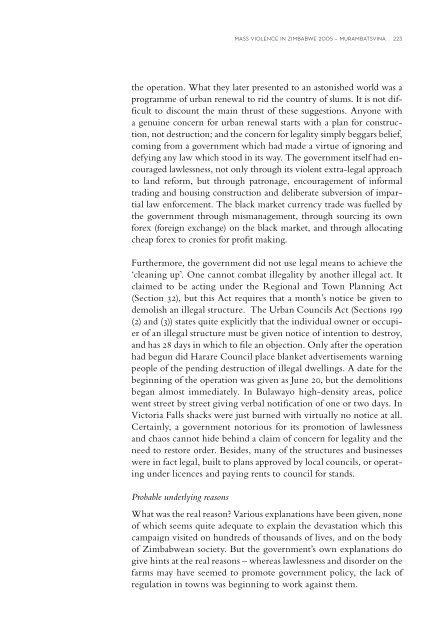60 years after the UN Convention - Dag Hammarskjöld Foundation
60 years after the UN Convention - Dag Hammarskjöld Foundation
60 years after the UN Convention - Dag Hammarskjöld Foundation
You also want an ePaper? Increase the reach of your titles
YUMPU automatically turns print PDFs into web optimized ePapers that Google loves.
mass violence in zimbabwe 2005 – murambatsvina 223<br />
<strong>the</strong> operation. What <strong>the</strong>y later presented to an astonished world was a<br />
programme of urban renewal to rid <strong>the</strong> country of slums. It is not diffi<br />
cult to discount <strong>the</strong> main thrust of <strong>the</strong>se suggestions. Anyone with<br />
a genuine concern for urban renewal starts with a plan for construction,<br />
not destruction; and <strong>the</strong> concern for legality simply beggars belief,<br />
coming from a government which had made a virtue of ignoring and<br />
defying any law which stood in its way. The government itself had encouraged<br />
lawlessness, not only through its violent extra-legal approach<br />
to land reform, but through patronage, encouragement of informal<br />
trading and housing construction and deliberate subversion of impartial<br />
law enforcement. The black market currency trade was fuelled by<br />
<strong>the</strong> government through mismanagement, through sourcing its own<br />
forex (foreign exchange) on <strong>the</strong> black market, and through allocating<br />
cheap forex to cronies for profi t making.<br />
Fur<strong>the</strong>rmore, <strong>the</strong> government did not use legal means to achieve <strong>the</strong><br />
‘cleaning up’. One cannot combat illegality by ano<strong>the</strong>r illegal act. It<br />
claimed to be acting under <strong>the</strong> Regional and Town Planning Act<br />
(Section 32), but this Act requires that a month’s notice be given to<br />
demolish an illegal structure. The Urban Councils Act (Sections 199<br />
(2) and (3)) states quite explicitly that <strong>the</strong> individual owner or occupier<br />
of an illegal structure must be given notice of intention to destroy,<br />
and has 28 days in which to fi le an objection. Only <strong>after</strong> <strong>the</strong> operation<br />
had begun did Harare Council place blanket advertisements warning<br />
people of <strong>the</strong> pending destruction of illegal dwellings. A date for <strong>the</strong><br />
beginning of <strong>the</strong> operation was given as June 20, but <strong>the</strong> demolitions<br />
began almost immediately. In Bulawayo high-density areas, police<br />
went street by street giving verbal notifi cation of one or two days. In<br />
Victoria Falls shacks were just burned with virtually no notice at all.<br />
Certainly, a government notorious for its promotion of lawlessness<br />
and chaos cannot hide behind a claim of concern for legality and <strong>the</strong><br />
need to restore order. Besides, many of <strong>the</strong> structures and businesses<br />
were in fact legal, built to plans approved by local councils, or operating<br />
under licences and paying rents to council for stands.<br />
Probable underlying reasons<br />
What was <strong>the</strong> real reason? Various explanations have been given, none<br />
of which seems quite adequate to explain <strong>the</strong> devastation which this<br />
campaign visited on hundreds of thousands of lives, and on <strong>the</strong> body<br />
of Zimbabwean society. But <strong>the</strong> government’s own explanations do<br />
give hints at <strong>the</strong> real reasons – whereas lawlessness and disorder on <strong>the</strong><br />
farms may have seemed to promote government policy, <strong>the</strong> lack of<br />
regulation in towns was beginning to work against <strong>the</strong>m.

















